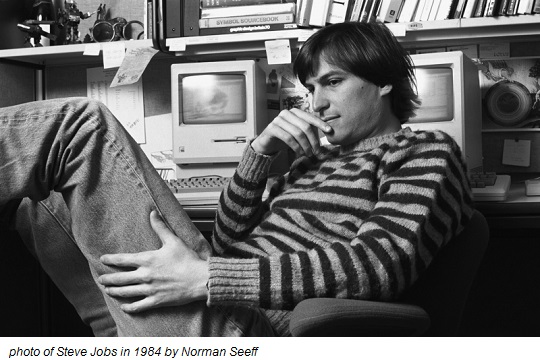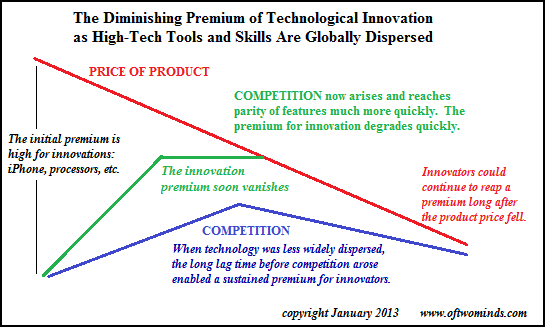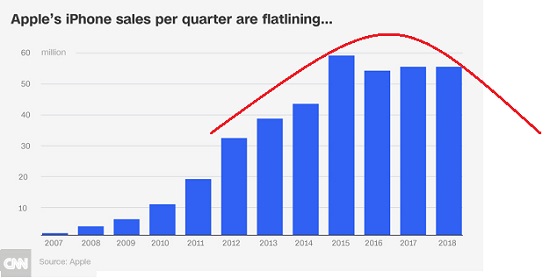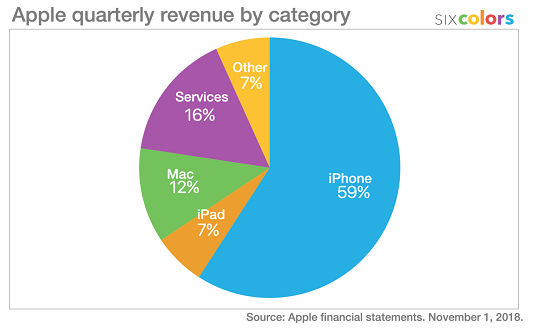Apple's Rotten Core
March 28, 2019
Entering commoditized, fiercely competitive low-margin services cannot substitute for the high-margin profits that will be lost as global recession and saturation erode iPhone sales.
Apple has always been equally an enterprise and a secular religion. The Apple Faithful do not tolerate heretics or critics, and non-believers "just don't get it."
So the first thing any critic must do is establish their credentials as a Believer: My first Mac model 0001 was the 21,447th made in week 32 of 1984 in Fremont, California. Now that we've established that, we can move on to my profound sense of anguished abandonment that Apple ceased producing the iPhone SE, the only form factor that works for me.
But Apple Faithful are accustomed to repeated bouts of anguished abandonment; it's just one of the burdens the faithful must bear.
Focusing on the enterprise rather than the religion, Apple's core--its revenue and profit potential--is rotten. As the charts below illustrate, despite all the happy talk about growing "services," the hardware-software iPhone generates nearly 60% of Apple's revenues. The iPhone ecosystem is also the foundation of the "services" currently being hyped as replacement sources of revenue.
The problem is that the proprietary features of the iPhone that have generated strong demand as prices kept rising are reaching diminishing returns. People want the status of owning an iPhone, but there are limits on what the bottom 90% can pay for that status.
The new features of the $1,000 iPhones have also reached diminishing returns. This is analogous with adding memory to a computer or increasing the pixel count in a digital camera: at some point, the added feature no longer has any impact on the user experience.
As the second chart illustrates, the market for costly mobile phones is saturated: everyone on the planet who could afford one and wants one has already bought one. As we all know, the "fix" for saturation is to speed up the product cycle so the existing owners are forced to buy a newer and much more costly model every year or two.
But this strategy also has diminishing returns: people get tired of getting ripped off by accelerating replacement cycles and eventually some percentage step off the merry-go-round and switch to a much cheaper and less demanding (product-cycle-wise) alternative.

Then there's the other problem: without Steve Jobs, there is no "next big thing" at Apple. As I've explained many times here and in my books, value flows to scarcity, and Apple's enormous profits are based on the artificial scarcity Apple has been able to impose on the market by closely guarding its proprietary mix of hardware and software.
But as this chart attempts to explain, the price innovators can charge as competition increases diminishes as the innovations lose their scarcity value. The faster the advances and product cycles, the faster the erosion of pricing power.
Why the Innovation Premium Is Diminishing (January 16,2013)

The innovations of late-cycle iPhones are out of synch with the price increases. Apple is moving from selling innovations worth an extra couple hundred dollars to resting on its status-symbol laurels as a "luxury brand."
That may work well in a global expansion, i.e. the past 10 years, but as the world economy contracts (don't dare call it recession), that strategy will not yield the same results it did in the expansionary cycle.
Lastly, the "services" Apple is entering are commoditized and extremely competitive, markets in which it has very little proprietary territory to defend. Payment systems and credit cards are commoditized markets: there is very little differentiating the options and the host of competitors is expanding rapidly.
Many competitors are well-funded and experienced in maintaining customer loyalty. Payment systems and credit cards aren't a sideline as they are for Apple; these are the banks' bread and butter and they will not make it easy for Apple to carve off a proprietary territory.
As I've also noted, commoditized products and services have low profit margins. Apple generated its tens of billions of dollars in profits by reaping extraordinary margins; those margins cannot be transferred to commoditized services.
The content creation and delivery sector is also commoditized and fiercely competitive. There is very little to differentiate the services and generate scarcity value, and as the global recession deepens, consumers will be paring back their subscriptions, not adding them. There is quite a lot of free content out there and those on a budget have many options.
What happens to Apple's "growth story" once iPhone sales decline and the much-hyped services generate a mere trickle of net profit?


Apple is facing a secular decline in its proprietary flagship that generated
huge profit margins. Entering commoditized, fiercely competitive low-margin services cannot
substitute for the high-margin profits that will be lost as global recession and saturation
erode iPhone sales.
Pathfinding our Destiny: Preventing the Final Fall of Our Democratic Republic
($6.95 ebook, $12 print, $13.08
audiobook):
Read the first section for free in PDF format.
My new mystery
The Adventures of the Consulting Philosopher: The Disappearance of Drake
is a ridiculously affordable $1.29 (Kindle) or $8.95 (print);
read the first chapters
for free (PDF)
My book
Money and Work Unchained is now $6.95 for the Kindle ebook and $15 for the print edition.
Read the first section for free in PDF format.
If you found value in this content, please join me in seeking solutions by
becoming
a $1/month patron of my work via patreon.com.
NOTE: Contributions/subscriptions are acknowledged in the order received. Your name and email remain confidential and will not be given to any other individual, company or agency.
|
Thank you, Marty N. ($5/month), for your monstrously generous pledge to this site -- I am greatly honored by your steadfast support and readership. |
Thank you, Steve H. ($5/month), for your splendidly generous pledge to this site -- I am greatly honored by your steadfast support and readership. |

|